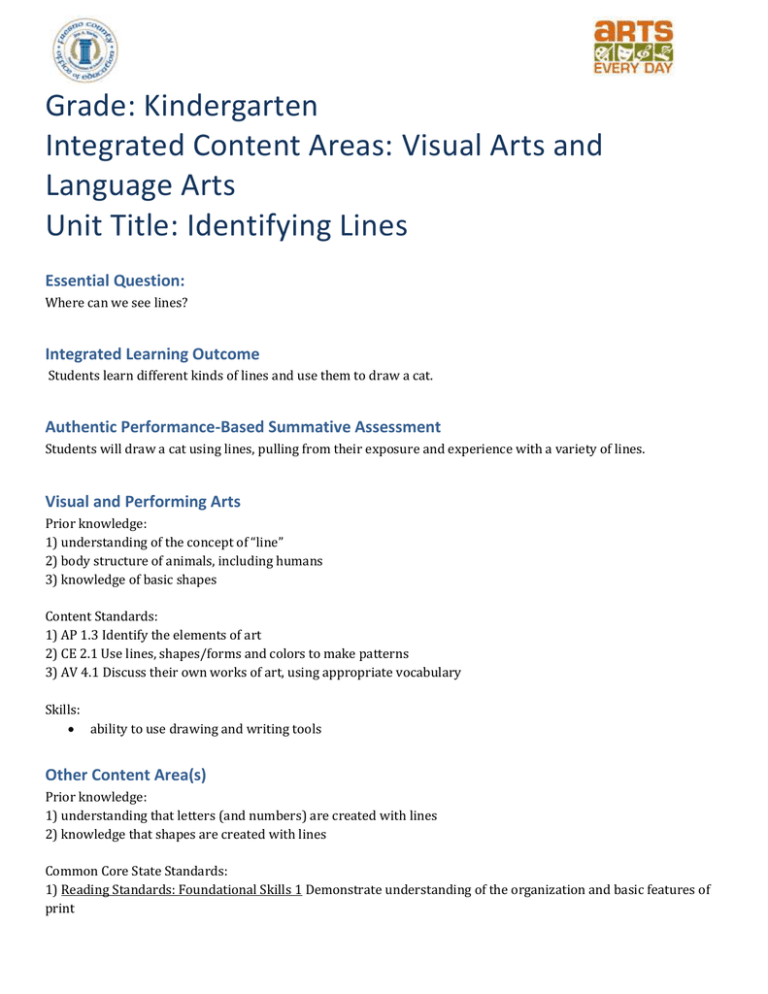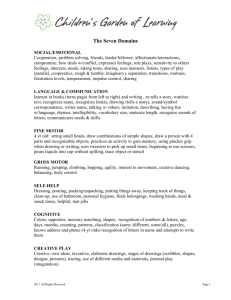Lesson Plan: Identifying Lines
advertisement

Grade: Kindergarten Integrated Content Areas: Visual Arts and Language Arts Unit Title: Identifying Lines Essential Question: Where can we see lines? Integrated Learning Outcome Students learn different kinds of lines and use them to draw a cat. Authentic Performance-Based Summative Assessment Students will draw a cat using lines, pulling from their exposure and experience with a variety of lines. Visual and Performing Arts Prior knowledge: 1) understanding of the concept of “line” 2) body structure of animals, including humans 3) knowledge of basic shapes Content Standards: 1) AP 1.3 Identify the elements of art 2) CE 2.1 Use lines, shapes/forms and colors to make patterns 3) AV 4.1 Discuss their own works of art, using appropriate vocabulary Skills: ability to use drawing and writing tools Other Content Area(s) Prior knowledge: 1) understanding that letters (and numbers) are created with lines 2) knowledge that shapes are created with lines Common Core State Standards: 1) Reading Standards: Foundational Skills 1 Demonstrate understanding of the organization and basic features of print 2) Speaking and Listening: Presentation of Knowledge and Ideas 4 Describe familiar people, places, things, and events 3) Language Standards: Vocabulary Acquisition and Use 4 Determine or clarify the meaning of unknown and multiple –meaning words and phrases based on kindergarten reading and content Skills: ability to using a writing instrument Text 1) www.moma.org (cats) 2) www.bing.com (cats in illustrations and art} 2) book: “Alphabet City”; alphabet forms found in structures 3) book: “The Wide Mouthed Frog”; story with animal illustrations 4) book: “Halloween Shapes”; geometrical Halloween shapes Creative Process (These phases of the creative process can be arranged in whatever order makes sense for this project. Phases will likely be repeated and will overlap as the project is worked on over time. In this section, describe the strategies used to activate these five phases.) Imagine / Examine / Perceive (What pieces of the unit of study require students to examine the world, perceive artwork or imagine something new?) Following a discussion of what a line is, students observed the classroom environment to identify lines. Lines continued to be identified in story illustrations, photographs, paintings, and letter and number formation. Explore / Experiment / Develop Craft (Which activities ask students to explore the content, experiment with ideas and build new skills?) Dry erase boards, erasers, and pens were provided to the class. With teacher direction, various types of lines and shapes were drawn and new vocabulary was introduced; scallops, wavy line, spirals, etc. Illustrations, paintings, and photographs of cats were then shown on a SmartBoard. Specific lines and shapes were traced over using a cursor with contrasting color to high-light line and shape. Noting their previous experience of overlaying geometric shapes on boards with geometric pattern pictures, the students were asked to create their own “pictures” with the shapes. Create (What pieces of the project are devoted to students creating their artwork?) Keeping in mind the various lines and shapes we’ve been learning about and experimenting with, students created their own cat drawings using pens on the dry erase boards. Finally, paper and crayons were provided and the students moved to their final piece of drawing a cat. Reflect / Assess / Revise (Which activities ask students to reflect on their work, assess their progress and revise their project? Throughout the creative processes noted above, students informally evaluated their own and others’ drawings and shape pictures. Revisions were especially easy in the preliminary activities because of the ease in erasing a dry erase board or a quick adjustment of a geometric shape. Share (How will students share their work with others?) Children will be provided an opportunity to share their work by presenting them before the class and talking about the techniques they used, and/or the stories behind them. Formative Assessment of the Visual and Performing Arts Content List tools or strategies. 1) Picture must be of a cat. 2) Basic anatomy of a cat should be included. Formative Assessment of Other Content Areas List tools or strategies. 1) Child should be able to describe their picture, including some pertinent art vocabulary. 2) Child should be able to “sign their artwork” using correctly formed letters. Summative Reflection Teacher: I felt that the drawings the children made on the dry erase boards were more interesting than those they drew with the crayons on paper; the pictures on the boards seemed to include more details and imagination. This could have been because the children knew that if they drew something that they didn’t quite like, the “mistake” could easily be fixed by erasing it, and, thus, they were less inhibited in their drawings. Student(s): Reflections about the big idea







